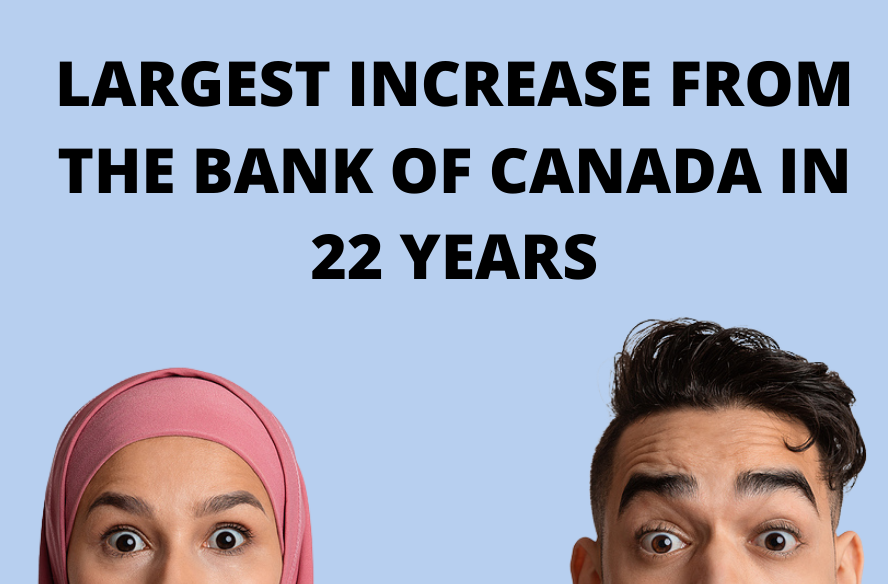The Bank of Canada announced this morning that they are increasing their key policy rate by 0.50% which will bring it to 1.00%. This is the rate that mortgage lenders use to set their prime rate, which will now increase to 3.20%.
The last time the BOC increased their rate by more than the typical 0.25% was back in 2000.
Despite the rarity of the larger increase, it was no big surprise and is exactly what was expected.
Why Such A Large Move?
Inflationary concerns are taken seriously by the Bank of Canada. To satisfy them, rates need to increase. The war in Ukraine has caused further disruption to the supply chain, which has thrown fuel on the already significant upward pressure on inflation. For this reason, the BOC needed to act more aggressively to keep it under control.
It’s possible that we haven’t seen the last of the double increases and it’s possible that we could see another one in their next scheduled announcement on June 1st.
The Bank of Canada will continue to increase their rate until inflation is under control. While we don’t like paying higher rates on our mortgage, we also don’t like paying higher prices for everything else. If they kept rates where they were, or minimized the increases, then this is what we would see. Our cost of living would increase substantially.
Immediate action was needed to prevent this.
If they get overly aggressive with subsequent increases then they’ll likely soar past their goal, resulting in significant decreases in inflation. Also, an economic recession in the near future is not only possible… but likely.
This would force rates back down.
The faster and more aggressively the Bank of Canada increases their rates, the sooner we will see rate cuts to follow. Despite what some doom and gloomers may lead you to believe, the scenario with rates continuing to rise over the next several years is not realistic.
How Will This Affect Your Payment?
For every 0.25% increase in rate, your payment will increase by roughly $12 for every $100,000 you owe on your mortgage. A 0.50% increase in rate would then mean a payment increase of roughly $24 for every $100K owed.
This will help you to determine how future increases will affect your payment as well.
Spread Between Fixed and Variable
After today’s increase, variable rates rate from 1.95% to 2.50% depending on your situation. The equivalent fixed rates range from 3.49% to 3.74%.
This is a spread of 1.24% – 1.54%. Even after the increase, this is STILL one of the largest spreads we’ve seen in years.
The larger spread gives you added protection.
Still….this spread could disappear by the end of the year if the Bank of Canada continues to act aggressively. That doesn’t mean that everyone should be taking fixed. Variable rates will move up and down over the term, and decreases are expected to follow the increases.
Variable Rate Risk
The risk with variable rate is that the future is unknown, and it’s always possible that the Bank of Canada could increase more than expected. Unexpected circumstances can arise, which can change the movement in one direction or another. The war in Ukraine is a perfect example of this….as is the pandemic.
Variable rate mortgages can still be a great choice, and I would expect them to still come out ahead over the fixed-rate alternatives over the next five years. You just need to be prepared to ride out the waves.
Should You Convert Your Variable Rate Into a Fixed?
Fixed mortgage rates have increased to 3.49% – 3.79%, depending on your situation. This is in line with where they were in early 2019. If you were to speak with your current lender about converting to a fixed, you’d likely be offered a rate in the 3.99% – 4.19% range, which are today’s ‘market’ 5 year fixed rates. You would need to switch lenders to access the heavily discounted rates mentioned above.
If you were to make the jump, you’d be locking into fixed rates when they are at a multi-year high. Yes, the prime rate will increase further, and your rate will increase along with it. But it will also decrease when the Bank of Canada starts to drop again…and they will.
Locking in now not only guarantees that you’re going to start paying significantly more interest immediately….. it means that you are locking yourself out of the expected variable rate discounts to follow. That’s the risk involved with locking into a fixed rate now.








Your article helped me a lot, is there any more related content? Thanks!
Glad to hear it helped Pumarehistro! You could check out the pervious blogs on this topic on the website.